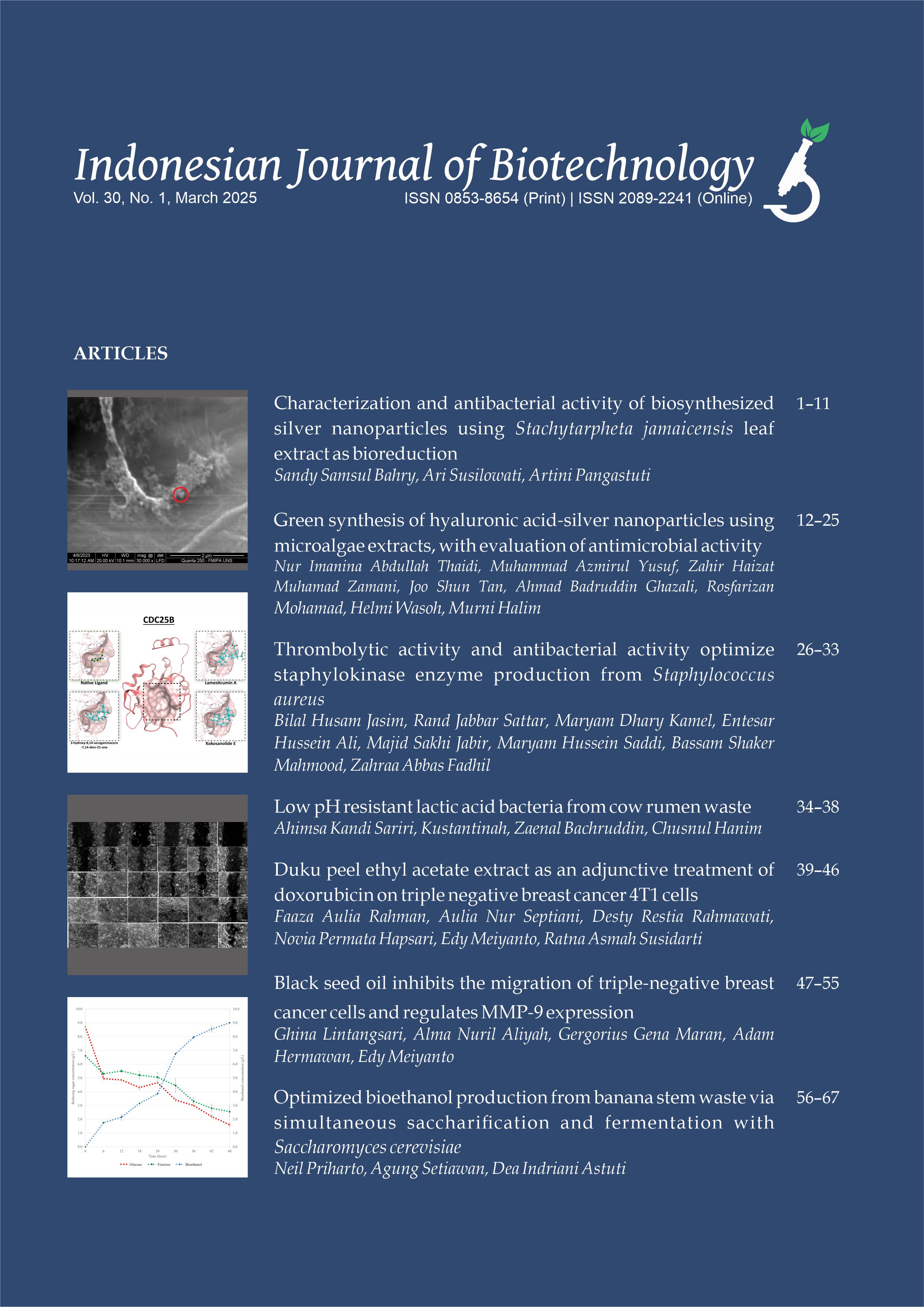Green synthesis of hyaluronic acid‐silver nanoparticles using microalgae extracts, with evaluation of antimicrobial activity
Nur Imanina Abdullah Thaidi(1), Muhammad Azmirul Yusuf(2), Zahir Haizat Muhamad Zamani(3), Joo Shun Tan(4), Ahmad Badruddin Ghazali(5), Rosfarizan Mohamad(6), Helmi Wasoh(7), Murni Halim(8*)
(1) Department of Bioprocess Technology, Faculty of Biotechnology and Biomolecular Sciences, Universiti Putra Malaysia, 43400, Serdang, Selangor, Malaysia; Bioprocessing and Biomanufacturing Research Complex, Universiti Putra Malaysia, UPM Putra InfoPort – IOI Resort, Jalan Kajang – Puchong, 43400 UPM Serdang, Selangor, Malaysia
(2) Department of Bioprocess Technology, Faculty of Biotechnology and Biomolecular Sciences, Universiti Putra Malaysia, 43400, Serdang, Selangor, Malaysia; Bioprocessing and Biomanufacturing Research Complex, Universiti Putra Malaysia, UPM Putra InfoPort – IOI Resort, Jalan Kajang – Puchong, 43400 UPM Serdang, Selangor, Malaysia
(3) Department of Bioprocess Technology, Faculty of Biotechnology and Biomolecular Sciences, Universiti Putra Malaysia, 43400, Serdang, Selangor, Malaysia
(4) Bioprocessing and Biomanufacturing Research Complex, Universiti Putra Malaysia, UPM Putra InfoPort – IOI Resort, Jalan Kajang – Puchong, 43400 UPM Serdang, Selangor, Malaysia; School of Industrial Technology, Universiti Sains Malaysia, 11800 Gelugor, Malaysia
(5) Department of Oral Maxillofacial Surgery and Oral Diagnosis, Kulliyyah of Dentistry, International Islamic University Malaysia, 25200 Kuantan, Malaysia
(6) Department of Bioprocess Technology, Faculty of Biotechnology and Biomolecular Sciences, Universiti Putra Malaysia, 43400, Serdang, Selangor, Malaysia; Bioprocessing and Biomanufacturing Research Complex, Universiti Putra Malaysia, UPM Putra InfoPort – IOI Resort, Jalan Kajang – Puchong, 43400 UPM Serdang, Selangor, Malaysia
(7) Department of Bioprocess Technology, Faculty of Biotechnology and Biomolecular Sciences, Universiti Putra Malaysia, 43400, Serdang, Selangor, Malaysia; Bioprocessing and Biomanufacturing Research Complex, Universiti Putra Malaysia, UPM Putra InfoPort – IOI Resort, Jalan Kajang – Puchong, 43400 UPM Serdang, Selangor, Malaysia
(8) Department of Bioprocess Technology, Faculty of Biotechnology and Biomolecular Sciences, Universiti Putra Malaysia, 43400, Serdang, Selangor, Malaysia; Bioprocessing and Biomanufacturing Research Complex, Universiti Putra Malaysia, UPM Putra InfoPort – IOI Resort, Jalan Kajang – Puchong, 43400 UPM Serdang, Selangor, Malaysia
(*) Corresponding Author
Abstract
Silver nanoparticles (AgNPs) exhibit excellent antimicrobial activity but face challenges such as aggregation and reduced effectiveness when used alone. To address these limitations, green synthesis methods utilizing biological agents as reducing agents have been explored to develop AgNP nanocomposites. This study synthesized AgNPs by incorporating hyaluronic acid (HA) with microalgae extracts from Arthrospira platensis, Chlorella vulgaris, and Nannochloropsis sp., resulting in HA‐AgNP nanocomposites. The experimental parameters, including pH, extract concentration, temperature and synthesis time, were optimized for the preparation of the HA‐AgNPs nanocomposites. The best HA‐AgNPs nanocomposites, synthesized by A. platensis (HA‐SP‐AgNPs), exhibited a Z‐average size of 66.98 nm and polydispersity index (PDI) of 0.494, indicating uniformity and stability. FTIR analysis confirmed the presence of functional groups associated with AgNPs, HA and A. platensis, ensuring structural stability. A key finding of the study is that HA‐SP‐AgNPs demonstrated enhanced antimicrobial activity against bacteria such as Staphylococcus aureus, Escherichia coli, and Bacillus subtilis. Notably, the HA‐SP‐AgNPs were particularly effective against S. aureus and E. coli compared to AgNPs alone. The results underscore the critical role of HA in enhancing nanoparticle stability and antibacterial efficacy, positioning HA‐SP‐AgNPs as a promising antimicrobial agent.
Keywords
Full Text:
PDFReferences
Abdel-Mohsen AM, Hrdina R, Burgert L, Abdel-Rahman RM, Hašová M, Šmejkalová D, Kolář M, Pekar M, Aly AS. 2013. Antibacterial activity and cell viability of hyaluronan fiber with silver nanoparticles. Carbohydr. Polym. 92(2):1177–1187. doi:10.1016/j.carbpol.2012.08.098.
Alipoor R, Ayan M, Hamblin MR, Ranjbar R, Rashki S. 2022. Hyaluronic acidbased nanomaterials as a new approach to the treatment and prevention of bacterial infections. Front. Bioeng. Biotechnol. 10:913912. doi:10.3389/fbioe.2022.913912.
Ameen F, Abdullah MM, AlHomaidan AA, AlLohedan HA, AlGhanayem AA, Almansob A. 2020. Fabrication of silver nanoparticles employing the cyanobacterium Spirulina platensis and its bactericidal effect against opportunistic nosocomial pathogens of the respiratory tract. J. Mol. Struct. 1217:128392. doi:10.1016/j.molstruc.2020.128392.
Annamalai J, Nallamuthu T. 2016. Green synthesis of silver nanoparticles: Characterization and determination of antibacterial potency. Appl. Nanosci. 6(2):259–265. doi:10.1007/s1320401504266.
Balouiri M, Sadiki M, Ibnsouda SK. 2016. Methods for in vitro evaluating antimicrobial activity: A review. J. Pharm. Anal. 6(2):71–79. doi:10.1016/j.jpha.2015.11.005.
Chugh D, Viswamalya VS, Das B. 2021. Green synthesis of silver nanoparticles with algae and the importance of capping agents in the process. J. Genet. Eng. Biotechnol. 19(1):126. doi:10.1186/s43141 02100228w.
Devaraj P, Kumari P, Aarti C, Renganathan A. 2013. Synthesis and characterization of silver nanoparticles using cannonball leaves and their cytotoxic activity against MCF7 cell line. J. Nanotechnol. 2013:598328. doi:10.1155/2013/598328.
Ferreira-Gonçalves T, Gaspar MM, Coelho JM, Marques V, Viana AS, Ascensão L, Carvalho L, Rodrigues CM, Ferreira HA, Ferreira D, Reis CP. 2022. The role of rosmarinic acid on the bioproduction of gold nanoparticles as part of a photothermal approach for breast cancer treatment. Biomolecules 12(1):71. doi:10.3390/biom12010071.
Govindaraju K, Basha SK, Kumar VG, Singaravelu G. 2008. Silver, gold and bimetallic nanoparticles production using singlecell protein (Spirulina platensis) Geitler. J. Mater. Sci. 43(15):5115–5122. doi:10.1007/s1085300827454.
Gupta V, Mohapatra S, Mishra H, Farooq U, Kumar K, Ansari MJ, Aldawsari MF, Alalaiwe AS, Mirza MA, Iqbal Z. 2022. Nanotechnology in cosmetics and cosmeceuticals—A review of latest advancements. Gels 8(3):173. doi:10.3390/gels8030173.
Haleem A, Javaid M, Singh RP, Rab S, Suman R. 2023. Applications of nanotechnology in medical field: a brief review. Glob. Heal. J. 7(2):70–77. doi:10.1016/j.glohj.2023.02.008.
Hanisha R, Balaganapathy M, Eswar B, Kathirvelan P, Rajabathar J, Siddiqui N, Dinakarkumar Y. 2024. Biogenic synthesis of silver nanoparticles using Spirulina maxima extract and their bactericidal activity. J.Umm AlQura Univ. Appll. Sci. doi:10.1007/s43994024 002034.
He W, Liu F, Tan L, Huang L, He S, Zhang L, Fan C. 2024. Investigation on different additions as candidates for nanooxide particles in nickelbased ODS superalloys. Mater. Charact. 209:113648. doi:10.1016/j.matchar.2024.113648.
Hintze V, Schnabelrauch M, Rother S. 2022. Chemical modification of hyaluronan and their biomedical applications. Front. Chem. 10:830671. doi:10.3389/fchem.2022.830671.
Hussein HA, Abdullah MA. 2022. Novel drug delivery systems based on silver nanoparticles, hyaluronic acid, lipid nanoparticles and liposomes for cancer treatment. Appl. Nanosci. 12(11):3071–3096. doi:10.1007/s13204021020189.
Ismail GA, ElSheekh MM, Samy RM, Gheda SF. 2021. Antimicrobial, antioxidant, and antiviral activities of biosynthesized silver nanoparticles by phycobiliprotein crude extract of the Cyanobacteria Spirulina platensis and Nostoc linckia. Bionanoscience 11(2):355–370. doi:10.1007/s12668021008283.
Jacob JM, Ravindran R, Narayanan M, Samuel SM, Pugazhendhi A, Kumar G. 2021. Microalgae: A prospective low cost green alternative for nanoparticle synthesis. Curr. Opin. Environ. Sci. Heal. 20:100163. doi:10.1016/j.coesh.2019.12.005.
Jena J, Pradhan N, Nayak RR, Dash BP, Sukla LB, Panda PK, Mishra BK. 2014. Microalga Scenedesmus sp.: A potential lowcost green machine for silver nanoparticle synthesis. J. Microbiol. Biotechnol. 24(4):522– 533. doi:10.4014/jmb.1306.06014.
Kaliamurthi S, Selvaraj G, Çakmak ZE, Çakmak T. 2016. Production and characterization of spherical thermostable silver nanoparticles from Spirulina platensis (Cyanophyceae). Phycologia 55(5):568–576. doi:10.2216/1598.1.
Ke C, Sun L, Qiao D, Wang D, Zeng X. 2011. Antioxidant acitivity of low molecular weight hyaluronic acid. Food Chem. Toxicol. 49(10):2670–2675. doi:10.1016/j.fct.2011.07.020.
Li X, Xu H, Chen ZS, Chen G. 2011. Biosynthesis of nanoparticles by microorganisms and their applications. J. Nanomater. 2011:1–16. doi:10.1155/2011/270974.
Liang J, Zeng F, Zhang M, Pan Z, Chen Y, Zeng Y, Xu Y, Xu Q, Huang Y. 2015. Green synthesis of hyaluronic acidbased silver nanoparticles and their enhanced delivery to CD44+ cancer cells. RSC Adv. 5(54):43733–43740. doi:10.1039/c5ra03083h.
Mahajan A, Arya A, Chundawat TS. 2019. Green synthesis of silver nanoparticles using green alga (Chlorella vulgaris) and its application for synthesis of quinolines derivatives. Synth. Commun. 49(15):1926– 1937. doi:10.1080/00397911.2019.1610776.
Mahdieh M, Zolanvari A, Azimee AS, Mahdieh M. 2012. Green biosynthesis of silver nanoparticles by Spirulina platensis. Sci. Iran. 19(3):926–929. doi:10.1016/j.scient.2012.01.010.
Mikhailova EO. 2020. Silver nanoparticles: Mechanism of action and probable BioApplication. J. Funct. Biomater. 11(4):84. doi:10.3390/jfb11040084.
Mondek J, Kalina M, Simulescu V, Pekař M. 2015. Thermal degradation of high molar mass hyaluronan in solution and in powder; comparison with BSA. Polym. Degrad. Stab. 120:107–113. doi:10.1016/j.polymdegradstab.2015.06.012.
More PR, Zannella C, Folliero V, Foglia F, Troisi R, Vergara A, Franci G, De Filippis A, Galdiero M. 2022. Antimicrobial applications of green synthesized bimetallic nanoparticles from Ocimum basilicum. Pharmaceutics 14(11):2457. doi:10.3390/pharmaceutics14112457.
Murugan K, Senthilkumar B, Senbagam D, AlSohaibani S. 2014. Biosynthesis of silver nanoparticles using Acacia leucophloea extract and their antibacterial activity. Int. J. Nanomedicine 9:2431–2438. doi:10.2147/IJN.S61779.
Namvar F, Azizi S, Rahman HS, Mohamad R, Rasedee A, Soltani M, Rahim RA. 2016. Green synthesis, characterization, and anticancer activity of hyaluronan/zinc oxide nanocomposite. Onco. Targets. Ther. 9:4549– 4559. doi:10.2147/OTT.S95962.
Pandian AMK, Karthikeyan C, Rajasimman M, Dinesh MG. 2015. Synthesis of silver nanoparticle and its application. Ecotoxicol. Environ. Saf. 121:211–217. doi:10.1016/j.ecoenv.2015.03.039.
Rashad S, ElChaghaby GA, Elchaghaby MA. 2019. Antibacterial activity of silver nanoparticles biosynthesized using Spirulina platensis microalgae extract against oral pathogens. Egypt. J. Aquat. Biol. Fish. 23(5 Special Issue):261–266. doi:10.21608/ejabf.2019.65907.
Saha P, Mahiuddin M, Islam AB, Ochiai B. 2021. Biogenic synthesis and catalytic efficacy of silver nanoparticles based on peel extracts of Citrus macroptera fruit. ACS Omega 6(28):18260–18268. doi:10.1021/acsomega.1c02149.
Salgın S, Salgın U, Vatansever Ö. 2017. Synthesis and characterization of β-Cyclodextrin nanosponge and its application for the removal of p-Nitrophenol from water. Clean Soil, Air, Water 45(10):1500837. doi:10.1002/clen.201500837.
SharifiRad M, Elshafie HS, Pohl P. 2024. Green synthesis of silver nanoparticles (AgNPs) by Lallemantia royleana leaf Extract: Their BioPharmaceutical and catalytic properties. J. Photochem. Photobiol. A Chem. 448:115318. doi:10.1016/j.jphotochem.2023.115318.
Shuai F, Zhang Y, Yin Y, Zhao H, Han X. 2021. Fabrication of an injectable iron (III) crosslinked alginatehyaluronic acid hydrogel with shearthinning and antimicrobial activities. Carbohydr. Polym. 260:117777. doi:10.1016/j.carbpol.2021.117777.
Singh T, Shukla S, Kumar P, Wahla V, Bajpai VK. 2017. Application of nanotechnology in food science: Perception and overview. Front. Microbiol. 8:1501. doi:10.3389/fmicb.2017.01501.
Sravani AN, Chandrasekaran N, Thomas J, Mukherjee A. 2023. Formulation and characterization of cisplatinloaded hydroxyl functionalized singlewalled carbon nanotubes for targeting gastric cancer stem cells. Heliyon 9(8):e18798. doi:10.1016/j.heliyon.2023.e18798.
Traiwatcharanon P, Timsorn K, Wongchoosuk C. 2015. Effect of pH on the green synthesis of silver nanoparticles through reduction with Pistiastratiotes L. extract. Adv. Mater. Res. 1131:223–226. doi:10.4028/www.scientific.net/amr.1131.223.
Vadakkan K, Rumjit NP, Ngangbam AK, Vijayanand S, Nedumpillil NK. 2024. Novel advancements in the sustainable green synthesis approach of silver nanoparticles (AgNPs) for antibacterial therapeutic applications. Coord. Chem. Rev. 499:215528. doi:10.1016/j.ccr.2023.215528.
Ying S, Guan Z, Ofoegbu PC, Clubb P, Rico C, He F, Hong J. 2022. Green synthesis of nanoparticles: Current developments and limitations. Environ. Technol. Innov. 26:102336. doi:10.1016/j.eti.2022.102336.
Yu J, Cheng L, Jia Z, Han X, Xu H, Jiang J. 2022. Injectable methylcellulose and hyaluronic acid hydrogel containing silver nanoparticles for their effective antimicrobial and wound healing activity after fracture surgery. J. Polym. Environ. 30(4):1330–1343. doi:10.1007/s10924021022575.
Zamboni F, Wong CK, Collins MN. 2023. Hyaluronic acid association with bacterial, fungal and viral infections: Can hyaluronic acid be used as an antimicrobial polymer for biomedical and pharmaceutical applications? Bioact. Mater. 19:458–473. doi:10.1016/j.bioactmat.2022.04.023.
Zhang X, Yao M, Chen M, Li L, Dong C, Hou Y, Zhao H, Jia B, Wang F. 2016. Hyaluronic acid coated silver nanoparticles as a nanoplatform for in vivo imaging applications. ACS Appl. Mater. Interfaces 8(39):25650–25653. doi:10.1021/acsami.6b08166.
AbdelMohsen AM, Hrdina R, Burgert L, AbdelRahman RM, Hašová M, Šmejkalová D, Kolář M, Pekar M, Aly AS. 2013. Antibacterial activity and cell viability of hyaluronan fiber with silver nanoparticles. Carbohydr. Polym. 92(2):1177–1187. doi:10.1016/j.carbpol.2012.08.098.Alipoor R, Ayan M, Hamblin MR, Ranjbar R, Rashki S. 2022. Hyaluronic acidbased nanomaterials as a new approach to the treatment and prevention of bacterial infections. Front. Bioeng. Biotechnol. 10:913912. doi:10.3389/fbioe.2022.913912.
Ameen F, Abdullah MM, AlHomaidan AA, AlLohedan HA, AlGhanayem AA, Almansob A. 2020. Fabrication of silver nanoparticles employing the cyanobacterium Spirulina platensis and its bactericidal effect against opportunistic nosocomial pathogens of the respiratory tract. J. Mol. Struct. 1217:128392. doi:10.1016/j.molstruc.2020.128392.
Annamalai J, Nallamuthu T. 2016. Green synthesis of silver nanoparticles: Characterization and determination of antibacterial potency. Appl. Nanosci. 6(2):259–265. doi:10.1007/s1320401504266.
Balouiri M, Sadiki M, Ibnsouda SK. 2016. Methods for in vitro evaluating antimicrobial activity: A review. J. Pharm. Anal. 6(2):71–79. doi:10.1016/j.jpha.2015.11.005.
Chugh D, Viswamalya VS, Das B. 2021. Green synthesis of silver nanoparticles with algae and the importance of capping agents in the process. J. Genet. Eng. Biotechnol. 19(1):126. doi:10.1186/s43141 02100228w.
Devaraj P, Kumari P, Aarti C, Renganathan A. 2013. Synthesis and characterization of silver nanoparticles using cannonball leaves and their cytotoxic activity against MCF7 cell line. J. Nanotechnol. 2013:598328. doi:10.1155/2013/598328.
FerreiraGonçalves T, Gaspar MM, Coelho JM, Marques V, Viana AS, Ascensão L, Carvalho L, Rodrigues CM, Ferreira HA, Ferreira D, Reis CP. 2022. The role of rosmarinic acid on the bioproduction of gold nanoparticles as part of a photothermal approach for breast cancer treatment. Biomolecules 12(1):71. doi:10.3390/biom12010071.
Govindaraju K, Basha SK, Kumar VG, Singaravelu G. 2008. Silver, gold and bimetallic nanoparticles production using singlecell protein (Spirulina platensis) Geitler. J. Mater. Sci. 43(15):5115–5122. doi:10.1007/s1085300827454.
Gupta V, Mohapatra S, Mishra H, Farooq U, Kumar K, Ansari MJ, Aldawsari MF, Alalaiwe AS, Mirza MA, Iqbal Z. 2022. Nanotechnology in cosmetics and cosmeceuticals—A review of latest advancements. Gels 8(3):173. doi:10.3390/gels8030173.
Haleem A, Javaid M, Singh RP, Rab S, Suman R. 2023. Applications of nanotechnology in medical field: a brief review. Glob. Heal. J. 7(2):70–77. doi:10.1016/j.glohj.2023.02.008.
Hanisha R, Balaganapathy M, Eswar B, Kathirvelan P, Rajabathar J, Siddiqui N, Dinakarkumar Y. 2024. Biogenic synthesis of silver nanoparticles using Spirulina maxima extract and their bactericidal activity. J.Umm AlQura Univ. Appll. Sci. doi:10.1007/s43994024 002034.
He W, Liu F, Tan L, Huang L, He S, Zhang L, Fan C. 2024. Investigation on different additions as candidates for nanooxide particles in nickelbased ODS superalloys. Mater. Charact. 209:113648. doi:10.1016/j.matchar.2024.113648.
Hintze V, Schnabelrauch M, Rother S. 2022. Chemical modification of hyaluronan and their biomedical applications. Front. Chem. 10:830671.
doi:10.3389/fchem.2022.830671.
Hussein HA, Abdullah MA. 2022. Novel drug delivery systems based on silver nanoparticles, hyaluronic acid, lipid nanoparticles and liposomes for cancer treatment. Appl. Nanosci. 12(11):3071–3096. doi:10.1007/s13204021020189.
Ismail GA, ElSheekh MM, Samy RM, Gheda SF. 2021. Antimicrobial, antioxidant, and antiviral activities of biosynthesized silver nanoparticles by phycobiliprotein crude extract of the Cyanobacteria Spirulina platensis and Nostoc linckia. Bionanoscience 11(2):355–370. doi:10.1007/s12668021008283.
Jacob JM, Ravindran R, Narayanan M, Samuel SM,
Article Metrics
Refbacks
- There are currently no refbacks.
Copyright (c) 2025 The Author(s)

This work is licensed under a Creative Commons Attribution-ShareAlike 4.0 International License.









